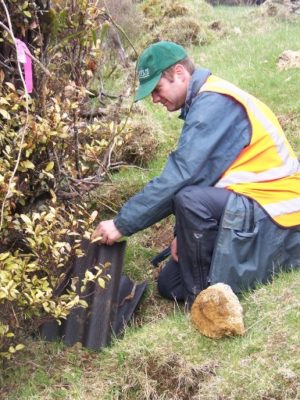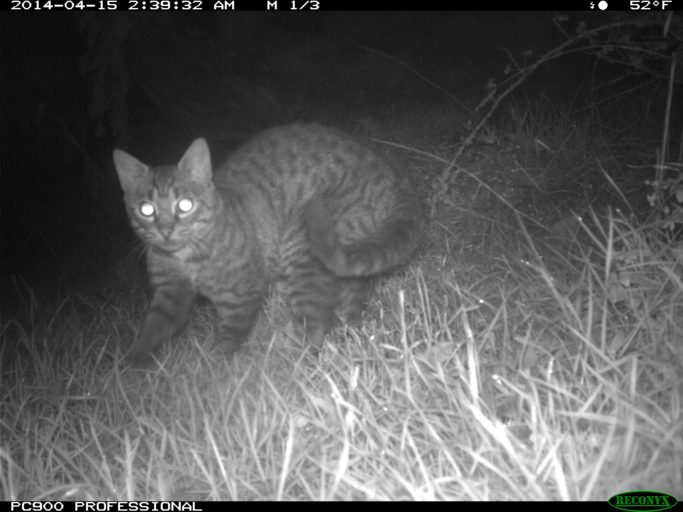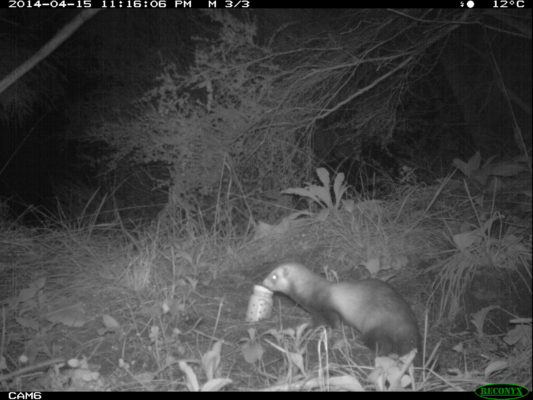Monitoring cryptic animals is one of the big challenges of becoming predator free, according to Auckland-based Landcare Research scientist, Dr Al Glen.
“Predators are cryptic,” he says, “and when they’re in low abundance, it’s very hard to detect the last few. Better monitoring is a priority.”
Al’s recent research has involved both motion-triggered camera traps and detector dogs. When cameras are compared with canines, the dogs have some distinct advantages.

“A dog can find the one stoat left in a sanctuary,” he says. “Where there’s a single incursion, a dog is brilliant. What’s more, a dog can also help catch predators. A camera can tell you a predator is there, but it can’t help catch it.”
Better motion-triggered cameras and a better understanding of the best ways to use them are an important tool as we work towards a predator-free future. There is, however, no single, simple answer to how camera traps should best be used.
“It depends on your target species, the size of the area you’re monitoring, whether you’re monitoring for relative abundance (eg ‘are there fewer predators after a control operation than there were before it?’) rather than absolute predator numbers, whether you’re trying to obtain behavioural information or trying to find out what predator is killing chicks,” Al explains.
As part of his advisory work, Al gets a lot of emails and phone calls from community groups seeking advice on how to monitor predators. He also gives presentations at workshops, conferences and hui. The importance of monitoring is becoming better understood, he believes.
“We need to do more monitoring, but it’s going in the right direction,” he says.
Why monitoring matters
Stretched resources are often an issue for community groups, limiting the amount of monitoring they feel they can do.
“It’s an understandable feeling,” Al admits, “Groups don’t want to spend money, time and volunteer effort on monitoring when that time and money could be spent on kill traps and bait stations. But it doesn’t make sense not to monitor,” he argues. “If you’re not monitoring as well then you don’t know if what you’re doing is working. You could be wasting ALL your resources!”
“It is absolutely vital to monitor the number of pests that you’re trying to control and the response in biodiversity. It is a waste of time if you’re not seeing a biodiversity response.”So what can monitoring tell you?
“Monitoring will tell you if you need to do more trapping,” Al says. “It can direct your trapping to particular locations. It might even tell you that you’re ‘overdoing it’ and save you some money.”
Camera costs

For small community conservation groups keen to do more monitoring, funding for equipment is likely to be an issue, although like most technology, camera traps are getting better and coming down in price.
“You can get a very good trail camera for $200,” says Al, “But the number of cameras you’ll need depends on the size of the area and the mobility of the species you’re tracking.”
For feral cats and mustelids, the recommended spacing is one camera every 500 metres. Cameras might need to be in place for 3-6 weeks.
“If there’s a control operation planned, you’d have cameras in place for 3 weeks beforehand and leave them in place for three weeks afterwards,” Al says.
Shared system?
The short period of time that a group might need to use monitoring cameras means that some sort of shared system could be possible.
“There’s a lot of demand for a trail camera ‘hire pool’,” agrees Al, “A lot of people have had a similar idea and there is a need out there. But there is no hire pool at the moment. Camera theft would also be an issue,” he adds, “particularly if the cameras were visible in a publicly accessed area.”
Considering the importance of monitoring by community groups however, and the expense of cameras, a regional sharing system may well be something that needs to be looked at in the future.
Poutiri Ao ō Tāne
As a part of his research role at Landcare Research, Al Glen has been closely involved with Hawkes Bay Regional Council’s innovative, landscape-scale ‘Cape to City’ Project and with the earlier Poutiri Ao ō Tāne pest control programme which was a precursor to it.
“Landcare Research has been monitoring the abundance of predators for Poutiri Ao ō Tāne and the biodiversity response,” says Al. “The procedures used in ‘Cape to City’ were developed during Poutiri Ao ō Tāne.”
Skinks
One positive surprise during the biodiversity monitoring was the appearance of native skinks.
“There was a really strong response from native skinks. Before predator control, there were no skinks seen anywhere. Now they’re everywhere. For such a quick response, they must have been there all along,” Al explains. “And the increase in visibility was too quick to be a breeding response. They’ve become more active and more visible (in behaviour), so now we’re picking them up in tracking tunnels.”

The skinks are now tracking at 40-50% abundance in the predator controlled area.
Al’s monitoring cameras in the ‘Cape to City’ project have picked up “hundreds of thousands” of photos.
“It’s a lot of data to use,” he admits. “At the moment we’re concentrating on cats and mustelids (stoats, ferrets and the occasional weasel), but the cameras pick up any animal. We’ve actually got more photos of hedgehogs, rats and mice – and lots of photos of tui – and we will eventually use that information too. As ‘Cape to City’ progresses,” he says, “we hope we might pick up kiwi!”
Al uses scent lures at the camera traps.
Tip to share
“Most camera trapping doesn’t use lures. Instead, cameras are placed at likely spots such as fence-lines and roadsides. But predators are fast-moving,” he explains. “At full speed you can just get a blurry photo. With a lure they slow and pause and you get a good photo.”
The photos are just the beginning for Al and his team. The trap data is then fed into sophisticated mathematical models in order to estimate population density. Currently they’re looking at the data from Hawkes Bay in order to find the best combination of camera method and data analysis method for monitoring feral cats.
Community groups wanting to monitor predators and biodiversity using motion cameras, should not be alarmed however. Simpler methods of analysis are possible for everyday situations. You don’t need to have a PhD in statistical methods.
“Occupancy modelling is one technique,” Al explains. “Instead of calculating how many predators there are, you look at how much of the landscape is being used – so you might get a reduction from 90% to 40%. You can do a simple index – as with trapping tunnels – where you count the number of cats for example, per 100 camera trap days. The trick,” he adds, “is to count the number of separate encounters, not 20 photos of one cat!”
Community groups wanting advice on how best to use camera traps can contact Al Glen at Landcare Research, Auckland.

